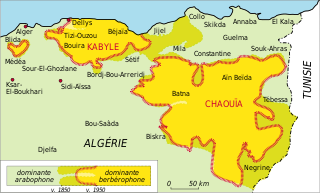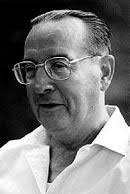
Tifinagh is a script used to write the Berber languages. Tifinagh is descended from the ancient Libyco-Berber alphabet. The traditional Tifinagh, sometimes called Tuareg Tifinagh, is still favored by the Tuareg Berbers of the Sahara desert in southern Algeria, northeastern Mali, northern Niger and northern Burkina Faso for use writing the Tuareg Berber language. Neo-Tifinagh is an alphabet developed by Berber Academy to adopt Tuareg Tifinagh for use with Kabyle; it has been since modified for use across North Africa.
Zenaga is a Berber language on the verge of extinction currently spoken in Mauritania and northern Senegal by a few hundred people. Zenaga Berber is spoken as a mother tongue from the town of Mederdra in southwestern Mauritania to the Atlantic coast and in northern Senegal. The language is recognized by the Mauritanian government.

Kabyle or Kabylian is a Berber language spoken by the Kabyle people in the north and northeast of Algeria. It is spoken primarily in Kabylia, east of the capital Algiers and in Algiers itself, but also by various groups near Blida, such as the Beni Salah and Beni Bou Yaqob.(extinct?)
The Zenati languages are a branch of the Northern Berber language family of North Africa. They were named after the medieval Zenata Berber tribal confederation. They were first proposed in the works of French linguist Edmond Destaing (1915) (1920–23). Zenata dialects are distributed across the central Berber world (Maghreb), from northeastern Morocco to just west of Algiers, and the northern Sahara, from southwestern Algeria around Bechar to Zuwara in Libya. The most widely spoken Zenati languages are Tmazight of the Rif in northern Morocco and Tashawit Berber in northeastern Algeria, each of which have over 3 million speakers.

The Chaoui people or Shawia are an Amazigh (Berber) ethnic group native to the Aurès region in northeastern Algeria which spans Batna and Khenchla, Oum El Bouaghi provinces located in and surrounded by the Aurès Mountains.

Marie-Louise-Taos Amrouche was an Algerian writer and singer. In 1947, she became the first Algerian woman to publish a novel.

The Berber calendar is the agricultural calendar traditionally used by Berbers,. The calendar is utilized to regulate the seasonal agricultural works.

Encyclopédie berbère is a French-language encyclopaedia dealing with subjects related to the Berber peoples, published both in print editions and in a partial online version.

Gabriel Camps was a French archaeologist and social anthropologist, the founder of the Encyclopédie berbère and is considered a prestigious scholar on the history of the Berber people.
Proto-Berber or Proto-Libyan is the reconstructed proto-language from which the modern Berber languages descend. Proto-Berber was an Afroasiatic language, and thus its descendant Berber languages are cousins to the Egyptian language, Cushitic languages, Semitic languages, Chadic languages, and the Omotic languages.

Tamazight of Djerba, Chelha of Djerba, or Djerbi is a Berber language of the Eastern Maghreb, spoken on the island of Djerba, in Tunisia. It is a component of what is regularly denominated Tunisian “Chelha” or "Shilha" in the south of the country.

Zayanes are a Berber population inhabiting the Khenifra region, located in the central Middle Atlas mountains of Morocco.
Beni Snous is a Berber variety close to Zenati languages spoken near Tlemcen in Algeria.
Centre de Recherche Berbère is a department at the Institut national des langues et civilisations orientales (INALCO) specializing in the Berber languages. The center is the oldest organization which focuses on Berber culture and language, being one of the very few to do so. It cooperates with the Institut royal de la culture amazighe du Maroc and programs at Moroccan universities.

South Oran Berber, or Tachelhit, is a cluster of the Zenati languages, which belong to the Berber branch of the Afroasiatic family. It is spoken in a number of oases of southwestern Algeria and across the border in Morocco.

Gurara (Gourara) is a Zenati Berber language spoken in the Gourara (Tigurarin) region, an archipelago of oases surrounding the town of Timimoun in southwestern Algeria. Ethnologue gives it the generic name Taznatit ("Zenati"), along with Tuwat spoken to its south; however, Blench (2006) classifies Gurara as a dialect of Mzab–Wargla and Tuwat as a dialect of the Riff languages.

Yennayer is the first month of the Amazigh Year, and has been used since antiquity by the Imazighen in North Africa. The first day of Yennayer corresponds to the first day of January in the Julian Calendar, which is shifted thirteen days compared to the Gregorian calendar, thus falling on 14 January every year. The Amazigh calendar was created in 1980 by Ammar Negadi, a Paris-based Algerian scholar. He chose 943 BC, the year in which the Amazigh Shoshenq I ascended to the throne of Egypt, as the first year of the Amazigh calendar.

Berbère Télévision is a TV channel broadcasting in Tamazight language from Montreuil. Berbère Télévision was set up by BRTV Group.
Salem Chaker is an Algerian linguist. A specialist in Berber linguistics, he is recognized as the "dean" of modern Berber studies.

Jewelleryof the Berber cultures is a historical style of traditional jewellery that was worn by women mainly in rural areas of the Maghreb region in North Africa and inhabited by indigenous Berber people. Following long social and cultural traditions, Berber or other silversmiths in Morocco, Algeria and neighbouring countries created intricate jewellery with distinct regional variations. In many towns and cities, there were Jewish silversmiths, who produced both jewellery in specific Berber styles as well as in other styles, adapting to changing techniques and artistic innovations.







































